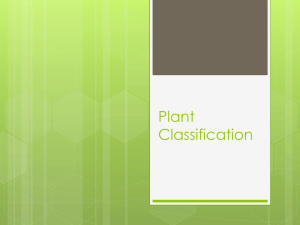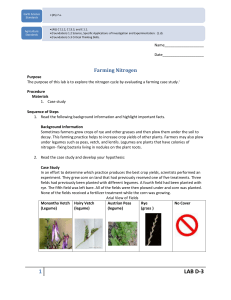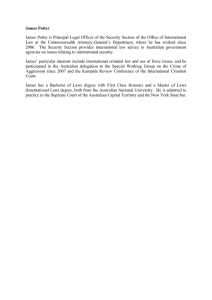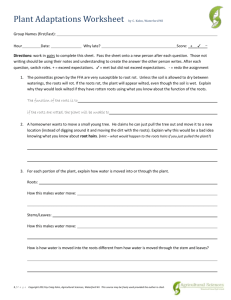POTENTIAL FOR REPLACING WI'IH MEDITERRANEAN EXPLORATION
advertisement
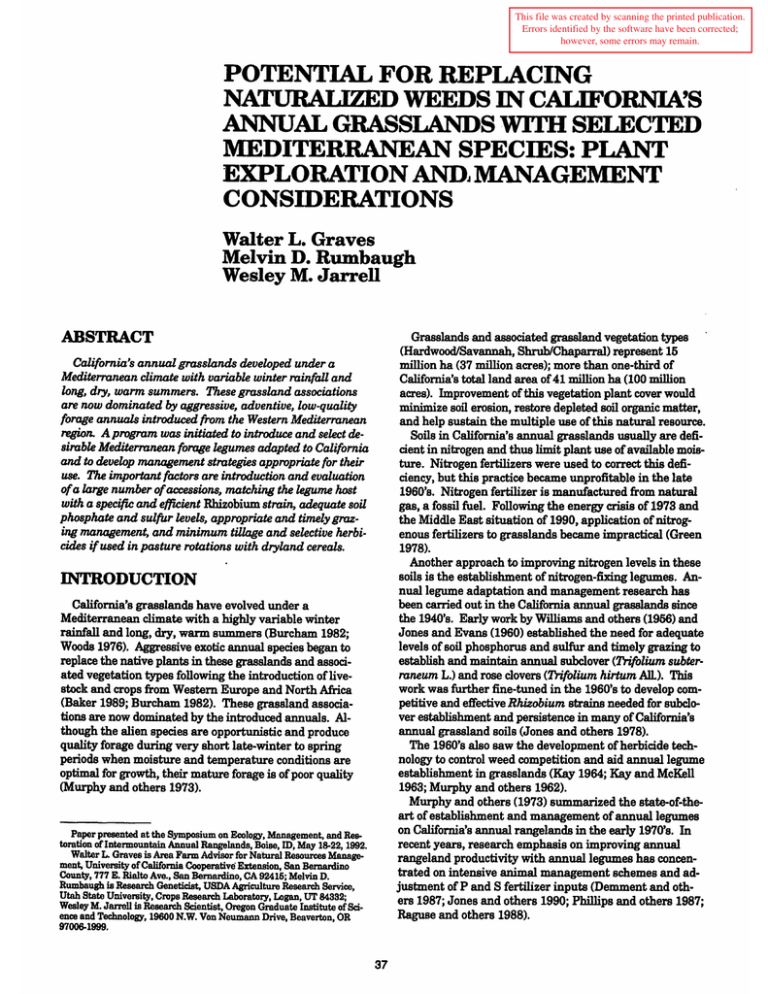
This file was created by scanning the printed publication. Errors identified by the software have been corrected; however, some errors may remain. POTENTIAL FOR REPLACING NATURALIZED WEEDS IN CALIFORNIA'S ANNUAL GRASSLANDS WI'IH SELECTED MEDITERRANEAN SPECIES: PLANT EXPLORATION ANDJMANAGEMENT CONSIDERATIONS Walter L. Graves Melvin D. Rumbaugh Wesley M. Jarrell ABSTRACT Grasslands and associated grassland vegetation types (Hardwood/Savannah, Shrub/Chaparral) represent 15 million ha (37 million acres); more than one-third of California's total land area of 41 million ha (100 million acres). Improvement of this vegetation plant cover would minimize soil erosion, restore depleted soil organic matter, and help sustain the multiple use of this natural resource. Soils in California's annual grasslands usually are deficient in nitrogen and thus limit plant use of available moisture. Nitrogen fertilizers were used to correct this deficiency, but this practice became unprofitable in the late 1960's. Nitrogen fertilizer is manufactured from natural gas, a fossil fuel. Following the energy crisis of 1973 and the Middle East situation of 1990, application of nitrogenous fertilizers to grasslands became impractical (Green 1978). Another approach to improving nitrogen levels in these soils is the establishment of nitrogen-fixing legumes. Annuallegume adaptation and management research has been carried out in the California annual grasslands since the 1940's. Early work by Williams and others (1956) and Jones and Evans (1960) established the need for adequate levels of soil phosphorus and sulfur and timely grazing to establish and maintain annual subclover (Trifolium subterraneum L.) and rose clovers (Trifolium hirtum All.). This work was further fine-tuned in the 1960's to develop competitive and effective Rhizobium strains needed for subclover establishment and persistence in many of California's annual grassland soils (Jones and others 1978). The 1960's also saw the development of herbicide technology to control weed competition and aid annual legume establishment in grasslands (Kay 1964; Kay and McKell 1963; Murphy and others 1962). Murphy and others (1973) summarized the state-of-theart of establishment and management of annual legumes on California's annual rangelands in the early 1970's. In recent years, research emphasis on improving annual rangeland productivity with annual legumes has concentrated on intensive animal management schemes and adjustment of P and S fertilizer inputs (Demment and others 1987; Jones and others 1990; Phillips and others 1987; Raguse and others 1988). California's annual grasslands developed under a Mediterranean climate with variable winter rainfall and long, dry, warm summers. These grassland associations are now dominated by aggressive, adventive, low-quality forage annuals introduced from the Western Mediterranean region. A program was initiated to introduce and select desirable Mediterranean forage legumes adapted to California and to develop management strategies appropriate for their use. The important factors are introduction and evaluation ofa large number of accessions, matching the legume host with a specific and efficient Rhizobium strain, adequate soil phosphate and sulfur levels, appropriate and timely grazing management, and minimum tillage and selective herbicides if used in pasture rotations with dryland cereals. INTRODUCTION California's grasslands have evolved under a Mediterranean climate with a highly variable winter rainfall and long, dry, warm summers (Burcham 1982; Woods 1976). Aggressive exotic annual species began to replace the native plants in these grasslands and associated vegetation types following the introduction of livestock and crops from Western Europe and North Africa (Baker 1989; Burcham 1982). These grassland associations are now dominated by the introduced annuals. Although the alien species are opportunistic and produce quality forage during very short late-winter to spring periods when moisture and temperature conditions are optimal for growth, their mature forage is of poor quality (Murphy and others 1973). Paper presented at the Symposium on Ecology, Management, and Restoration of Intermountain Annual Rangelands, Boise, ID, May 18-22, 1992. Wolter L. Graves is Area Form Advisor for Natural Resources Management, University of California Cooperative Extension, Son Bernardino County, 777 E. Rialto Ave., Son Bernardino, CA 92416; Melvin D. Rumbaugh is Research Geneticist, USDA Agriculture Research Service, Utah State University, Crops Research Laboratory, Logan, UT 84332; Wesley M. Jarrell is Research Scientist, Oregon Graduate Institute of Science and Technology, 19600 N.W. Von Neumann Drive, Beaverton, OR 97006-1999. 37 While the introduction of annual legumes adapted to a Mediterranean climate and capable of biologically fixing significant amounts of nitrogen is promising, they are not being used on a large scale in the lower and less dependable rainfall regions of central and southern California. The establishment success of imported Australian cultivars, particularly subclovers, has been erratic. California's rainfall amounts and distribution are less dependable than in Mediterranean climate areas of Australia where annual legumes are commonly used (Graves and others 1991). The naturalized annual legume, bur medic (Medicago polymorpha L.), became an alternative host for the alfalfa weevil (Jlyperia brunneipennis) following its introduction as a pest on irrigated alfalfa (M. sativa) in the Central Valley. This weevil caused the decimation ofbur medic in much of the pasture area of the dryland grain-pasture rotation system on the west side of the Sacramento Valley. After the elimination ofbur medic, the soils of this system also became nitrogen deficient and regular applications of expensive nitrogen fertilizer are now needed to make this dryland grain-nonlegume annual grassland pasture rotation system productive (Graves and others 1987). Australian scientists and land managers developed techniques to displace i~troduced annual plants of poor forage quality with more desirable forage legumes, primarily subclover and annual medics (Medicago sp.) (Crawford and others 1989; Reed and others 1989). The Australian use of annual legumes in pastures in rotations with cereals, called "Ley Farming" in Australia, has been extensively reviewed by Puckridge and French (1983). An excellent review of subclover-based pasture establishment and management in Western Australia also is found in the 1983 issue of the Journal ofAgriculture of Western Australia (Gillespie and others 1983). Since the widespread sowing of subclovers in the 1920's and annual medics in the 1930's, the Australian experience in establishing and managing some 40 million ha (99 million acres) of annual legumes emphasizes the importance of the correct legume-Rhizobium association, cultivar screening and selection, macro and micro soil nutrients availability, grazing management to control undesirable weedy species, and the use of selective herbicides and shallow tillage in pasture-dryland cereal rotations (Carter 1987; Crawford and others 1989; Reed and others 1989). In recent years, factors affecting legume seed bank ecology have received considerable attention. Maintaining optimum levels of seed reserves of target legume species is important for long-term persistence and productivity (Carter 1989). The Australian pasture legume researchers make a strong case for the value of the accidental introductions into Australia, in the 19th century, of annual legumes from countries bordering the Mediterranean Sea (Cocks and others 1979; Gladstones 1966, 1967). They continue to emphasize Mediterranean region plant exploration programs to search for better adapted and more persistent legume germplasm (Crawford 1983; Crawford and others 1989; Francis and Gladstones 1983). Although Australian and California annual legume establishment and management technology have similar historical development patterns and common principles and practices, we do have one important difference-California was not blessed with opportune accidental introductions of annual legumes other than the weevil-susceptible bur medic. Until recently, we had not thought it necessary to conduct plant explorati~ns to the Mediterranean regions to improve our annual legume germplasm base. Instead, we depended heavily on the Australian cultivar development and seed production program to meet our annual legume introduction needs. The USDA National Plant Introduction Program was initiated in 1898. However, by 1979 only a very limited number of annual legume introductions that performed well in California's annual grasslands had been acquired (White and Oakes 1979). Although preliminary annual legume testing and evaluations by Graves and others (1980) in southern California in the 1970's demonstrated that there was a potential for more extensive annual legume use in this area, the cultivars available to us at that time did not seem to possess persistence characteristics suited to our highly variable annual rainfall pattern. While the Australian cultivars were not adapted to our environment, the principles used in the Australian plant exploration and selection programs seemed to be worthy of consideration. We needed to develop our own plant exploration program to target climatic analogs and search for annual legume ecotypes that had evolved and persisted under similarly harsh conditions. The 1980's saw this goal achieved and our hypothesis tested. This plant exploration program is covered in more detail in Graves and others (1987 and 1991) and Rumbaugh and Graves (1985). It is the objective of this paper to report on the field testing of these annual legume introductions from our plant exploration and exchange program with Mediterranean collaborators and the adaptation of this plant material to the annual grasslands of southern California. FIELD TRIALS Oak-Annual Grassland (Savannah) MiddleElevation Site-This evaluation of annual legume introductions from our 1983 plant exploration program in Morocco (Rumbaugh and Graves 1985) was initiated in the fall of 1984. It included accessions that we had targeted as originating in zones of similar climate pattern. The trial consisted of20 entries of 11 wild subclover accessions native to Morocco, four Australian subclover cultivars, three naturalized rose clovers from northern California, and two Australian rose clover cultivars. The test site is located in San Diego County at 975 m (3,200 ft) in a 600-mm (23.6-inch) September 1 through May 31 effective seasonal rainfall zone. Details of the materials and methods and site characteristics have been reported and the evaluations for the first 4 years of testing summarized (Graves and others 1991). The significance of persistence evaluation in this zone is the lack of success of annual legume establishment and the fact that a somewhat long drought and poor rainfall distribution period occurred over a 5-year span from the 1986/87 season through the 1990/91 season. Plots were located in an open range pasture and were not fenced to exclude grazing. The pasture with the test plots received continuous moderate grazing by cattle during the late 38 winter and spring growing seasons in the establishment year and throughout the duration of the 8-year evaluation period. Stand cover evaluations were made each spring near the end of the growing season by visually rating plot cover on a 0-10 scale (0 =no plants, 10 =complete ground cover of the seeded plot). Stand regeneration was defined as the annual clover's ability to regenerate its cover within the planted plot of 1.45 m 2 (16 ft2). The most recent stand persistence evaluations were made on April 24, 1992. Flowering also was recorded on the date of the 1988 stand ratings. Stand regeneration data were analyzed statistically for strain differences. Annual Grasslands-Lower Elevation Site-It is believed that hardseededness may be the most important characteristic that an annual legume may possess in order to persist in a highly variable rainfall region such as that found in southern California. Smith (1988) pointed out the importance of hardseededness as an adaptation and survival mechanism in the highly variable rainfall patterns characteristic of Mediterranean climates. The need to screen and breed for hardseededness in subclover was recognized in Australia (Francis and Gladstones 1983) and in Spain (Gomez Pitera and Ramos Monreal1980) as an important component of persistence in areas of 375 mm (15 inches) or less rainfall and for successful stand regeneration after cereal cropping. Gomez Pitera and Ramos Monreal (1980) screened more than 2,000 subclover lines from southern Spain for hardseededness, estrogen levels, and seed production, and a small number of the superior lines from this research were sent in the fall of 1979 to the University of California, Davis, for seed increase and field evaluations. Seven of these subclover lines of Spanish origin (Spanish Forage and Pasture Research Institute, Badajoz numbers: 1142, 59,245, 92, 312-A, 704 and 393) of high hardseededness were increased by Burgess Kay, wildlands reseeding specialist, at the Department of Agronomy and Range Science, University of California, Davis, during the spring of 1980 and distributed for field trials during the fall of 1980. During the 1980 to 1982 period these Spanish lines were established in annual grassland locations in San Diego and San Luis Obispo Counties. Medium-term evaluations were made on five lines in the spring of 1987 (Graves and others 1991). An additional trial with the seven Spanish lines was initiated near the town of Alpine in San Diego County in the fall of 1982, with the objective of evaluating long-term persistence. This test site is located at 714 m (2,345 ft), some 53 km (33 mi) inland to the east of the San Diego coast. The location is in the inland foothill climate zone with a mean annual rainfall of 450 mm (18 inches). The soil is a Wyman (fine-loamy, mixed, thermic, Typic Haploxeralfs) soil with neutral to slightly acid pH, loam to clay loam texture, 2-5 percent slope, and with low nitrogen, phosphorus, and organic matter levels. The site is classed as annual grassland and has been used for livestock grazing since the late 1800's. The site is dominated by filaree species CErodium sp.), annual bromes CBromus sp.), and foxtail fescue (Vulpia myros [L.] K.C. Gmelin var. hirsuta Hack). The seven Spanish lines and three early maturing hardseeded Australian subclover cultivars (Nungarin, Geraldton, and Daliak) were seeded on November 24, 1982. Single superphosphate (0-18-0-12) was applied by broadcasting at the rate of 300 kglha (277 lblacre) prior to seeding. One hundred seeds of each of the entries were planted 8 mm (0.33 inch) deep in 1.20-m (4-ft) single-row plots (no-till) arranged in a randomized block design, replicated four times. All seeds were freshly pellet-inoculated at the rate of 5 kg of inoculant per 100 kg of seed (Pelinoc inoculating system, Milwaukee, WI). The pasture containing the trial received continuous, moderate-to-heavy grazing by cattle during the winterspring growing season for the 10-year evaluation period. Plant stand evaluations were made April 6, 1983, to verify first-season establishment (by visually rating row cover on a 0 to 10 score (0 =no plants, 10 = complete coverage of the row). Stand persistence evaluations were made at the end of the tenth growing season, (April 24, 1992) to measure the subclover lines' long-term ability to regenerate following low rainfall (drought) years stress. Initial plant and 1992 plant stand persistence evaluations were analyzed statistically for strain differences. OAK-GRASSLAND RESULTS The results from this trial are most encouraging (table 1). Following the long 5-year drought from 1987 through 1991, three of the Moroccan subclovers regenerated and one experimental accession, GR 508 (PI 517171), was significantly (P < 0.05) superior to all other entries including the rose clover cultivars and the northern California naturalized lines. None of the Australian subclover cultivars, Seaton Park, Northam, Geraldton, or Nungarin, persisted. These results confirm the difficulty that we have had with the establishment and persistence of Australian subclover cultivars in this southern California zone. The Australian rose clover cultivars, Hykon and Kondinin, continue to show some degree of persistence, as did the naturalized collections from Mendocino, Shasta, and Siskiyou Counties. These three naturalized rose clover accessions are much later in maturity than the superior subclover accessions and the two rose clover cultivars, and we would expect these naturalized northern California lines to be at a disadvantage in this zone due to its short rainfall season. Thus, we would not expect the accessions to persist or, at best, to regenerate only during years of above-average rainfall. Considering that rainfall was 25 to 40 percent below average during this 5-year-long drought period (1987 to 1991), the test results are indicative of adaptation to the extreme stress conditions of this zone. At least one of the three persistent Moroccan accessions, GR 508 (PI 517171), has demonstrated the potential for long-term regeneration and adaptation to this annual grassland type of southern California. ANNUAL GRASSLAND RESULTS After 10 seasons, including 5 drought years from 1987 through 1991, Spanish experimental accession 1142 was significantly (P < 0.05) superior in stand persistence to all the other accessions, including the Australian cultivars (table 2). These results follow the pattern and confirm the findings as reported by Graves and others (1991) who used 39 Table 1-5ubclover (sub) and rose clover entries regeneration and flowering evaluations at the Alford Ranch, Mesa Grande, San Diego County. at the end of fourth and eighth growing seasons Ranking/plot coverage1 Fourth season Eighth season2 Variety/ accession GR 508 Sub (PI517171) GR 565 Sub (PI 517173) GR 567 Sub (PI517174) Shasta 4300' Rose Kondinin Rose Siskiyou Rose Mendocino Rose Hykon Rose Seaton Park Sub Northam Sub GR 435 Sub (PI517164) Geraldton Sub GR 448 Sub (PI 517167) GR 450 Sub (PI517168) GR 316 Sub (PI517155) GR 436 Sub (PI517165) GR 494 Sub (PI 517170) GR 519 Sub (PI517172) Nungarin Sub GR 301 Sub (PI 517154) Flowering on 3/29/8&3 8.8 6.2 72 3~ + + ~2 + a2 5.8 5.0 5.0 3.0 2.0 2.8 25 2.0 0 0 0 0 0 0 0 0 5~ 4.5 4.2 3.5 3.2 2.2 2.0 1.8 1.8 1.8 1.2 1.2 1.2 1.0 + + + + + + + 0 + 0 0 0 + + 1.5 LSD (0.05) of four repetitions (0 • no plants, 1o• complete coverage of plot). of variance calculation did not Include entries that did not persist; •o• (zero) ratings. .. flowers;- .. no flowers). 1Average 2Analysis 3 (+ Table 2-5panlsh and Australian subclover stand establishment, 1Oth-yr persistence, and flowering maturity date at the Alpine, San Diego County, site Straln/cultlvar 59 312-A 245 393 92 704 1142 Geraldton Daliak Nungarin LSD (0.05) 1Average Stand establishment on 4/6/831 Stand persistence 1Oth yr, 4/24/921 Flowering maturlty2 7.5 7.5 7.2 7.0 6.8 6.8 6.0 7.0 7.0 7.0 1.8 0 0 2.0 0 1.8 5.5 2.8 0 3.0 +3 +6 +3 +3 +3 +2 +3 +3 +3 0 0.8 ~.1 (4) of four repetitions (0 • no plants, 10 • complete coverage of the plot row). 2 (Weeks after Nungarin) Nungarin Is considered earliest of trial entries. 3Analysis of variance calculations did not Include entries that did not persist; 4Average of observations, no statistics completed. these same lines in other localities. The lack of persistence of the Australian cultivar Daliak confirmed the inability of this cultivar to adapt to the harsh conditions of southern California. The stand establishment ratings showed that most of the trial entries were similar in ability to establish the first year from the initial seeding. However, Spanish line 1142 showed a significantly lower plant stand (P s 0.05) ·o· (zero) ratings. than any of the other experimental lines or Australian cultivars. Yet, by the end of the lOth season, this line was the only trial entry that was regenerating at a desirable level of greater than 40 percent cover. The point to be made here is that under unfavorable and stressful climatic conditions there is a need for long-term evaluation trials to allow adaptability characteristics to express themselves. 40 We assume that early flowering gives the annual legumes an added adaptability advantage in escaping drought stress in low rainfall years; however, we can see from the poor showing of the Nungarin cultivar, the earliest flowering entry, this extreme early flowering characteristic is not the most important factor in helping the plant to persist in these conditions. While our results did not all9w us to choose between Spanish lines 1142 and 59 on the basis of other agronomic traits, this long-term trial does allow us to select line 1142 as the most persistent in the annual grassland zone of southern California. Gomez Pitera and the Servicio de Investigacion Agraria Spain, for seeds of the Spanish lines; Burgess Kay, Range Science Specialist, UCD for assistance in seed increase; our rancher cooperator, Spike Alford, of Mesa Grande; the resource management personnel of the Palomar District of the Cleveland National Forest; Henry Adams, USDA-SCS Range Specialist, San Diego County; and last and especially all our North African colleagues and friends who provided us guidance, encouragement, and shelter to undertake these plant exploration adventures in pursuit of rapidly disappearing legume germplasm from a region of extremely high-use pressures. SUMMARY REFERENCES These long-term persistence evaluations provide a very exciting example of the successful collection and introduction of wild-type annual legumes from native habitats in the Mediterranean region. We believe that our hypothesis of expecting to find wild types of annual legumes in analogous climatic zones in the Mediterranean region that offer a potential for adaptation under a number of varied and variable California environments has been confirmed. Several principles, practices, and techniques have been proven to be important for successfully displacing introduced annual Mediterranean plants of poor forage quality with more desirable forage annual legumes. These factors are plant exploration, plant introduction, evaluation of a large number of collections, and matching the legume host with an effective and competitive Rhizobium strain. Once the array of adapted annual legume types is found, their use will be optimized and sustained by providing them with adequate levels of soil-deficient nutrients, such as phosphorus and sulfur for the California annual grasslands. Timely and early-season animal grazing management will help to reduce poor-quality annual spe~es, optimize seed production, and increase nitrogen ~cling. Where these legumes can be used in pasture rotations with dryland cereal farming systems, one can use minimum tillage and selective herbicides to enhance the annual legume component and its regeneration. Our results point out the need to maintain a testing and evaluation program of present and future cultivar introductions to assess their adaptations to California conditions. Through continued exploration for better adapted and persistent annual legume plant materials, the annual grasslands and associated vegetation types of California can be restored and this natural resource sustained for multipleuse management needs. Baker, H. G. 1989. Sources of the naturalized grasses and herbs in California. In: Huenneke, L. F.; Mooney, H., eds. Grassland structure and function in California annual grasslands. Dordrecht, Netherlands: Kluwer: 29-38. Burcham, L. T. 1982. California range land: an historicoecological study of the range resources of California (orig. copyright 1957). Publ. 7. Davis, CA: Center for Archeological Research, University of California-Davis. 256 p. Carter, E. D. 1987. Establishment and natural regeneration of annual pastures. In: Wheeler, J. L.; Pearson, C. J.; Robards, G. E., eds. Temperate pastures. Melbourne: CSIRO: 35-51. Carter, E. D. 1989. The production and managment of pastures based on annual medics and clovers. In: Pasture symposium: proceedings; 1989 February 15. Adelaide: Waite Agricultural Research Institute, The University of Adelaide: 1-12. Cocks, P. S.; Mathison, M. J.; Crawford, E. J. 1979. From wild plants to pasture cultivars: annual medics and subterranean clovers in southern Australia. In: Summerfield, R. J .; Bunting, A. H., eds. Advances in legume science. Kew, England: Royal Botanic Gardens: 569-596. Crawford, E. J. 1983. Selecting cultivars from naturally occurring genotypes; evaluating annual Medicago species. In: Mcivor, J. G.; Bray, R. A., eds. Genetic resources of forage plants. Melbourne: CSffiO: 203-215. Crawford, E. J.; Lake, A. W. H.; Boyce, K. G. 1989. Breeding annual Medicago species for semiarid conditions in southern Australia. Advances in Agronomy. 42: 399-437. Demment, M. W.; Jones, M. B.; Deo, G. P.; Center, D. M.; Dally, M. R.; Williams, W. A. 1987. Fertilizing increased profitability of lamb production on small pastures. California Agriculture. 41(1 and 2): 6-8. Francis, C. M.; Gladstones, J. S. 1983. Expl\litation of the genetic resource through breeding: Trifolium subterraneum. In: Mcivor, J. G.; Bray, R. A., eds. Genetic Resources of Forage Plants. Melbourne: CSIRO: 251-260. Gillespie, D. J.; Ewing, M. A.; Nicholas, D. A. 1983. Subterranean clover establishment techniques. Journal of Agriculture-Western Australia. 24: 16-20. Gladstones, J. S. 1966. Naturalized subterranean clover (Trifolium subterraneum L.) in Western Australia: the strains, their distribution, characteristics, and possible origins. Australian Journal of Botany. 14: 329-354. Gladstones, J. S. 1967. Naturalized subterranean clover strains in western Australia: a preliminary agronomic examination. Australian Journal of Agricultural Research. 18: 713-731. Bad~oz, ACKNOWLEDGMENTS We express appreciation to Gary Reece, the late Elgy Kryger, Bob Eisele, and Bill Winans of the Watershed Program, Department of Agriculture, San Diego County, for their assistance in site preparation, encouragement, and logistical support throughout the long evaluation program in San Diego County. A special thanks goes to Victor Brown, UCCE County Director, whose encouragement and belief in our potential during the developmental years was invaluable. Others who provided valuable assistance were Carol Adams, UCCE (UCR) for statistical analysis; Carlos 41 Gomez Pitera, C.; Ramos Monreal, A. 1980. Estudios sabre madurez en una collection de treboles subterraneos extremenos. Pastas. 10:63-74. Graves, W. L.; Kay, B. L.; Ham, T. 1980. Rose clover controls erosion in southern California. California Agriculture. 34: 4-5. Graves, W. L.; Kay, B. L.; Jones, M. B.; Jarrell, W. M.; [and others]. 1987. Annual legume germplasm exploration and testing to improve range, pasture and soils in the winter-rainfall California climate. In: Frazier, G.; Evans, R. A., eds. Symposium-seed and seedbed ecology of rangeland plants: proceedings; 1987 April21-23; Tucson, AZ. Washington, DC: U.S. Department of Agriculture, Agricultural Research Service: 188-191. Graves, W. L.; Kay, B. L.; Jarrell, W. M.; Burton, J. C.; Wegrzyn, V.; Rumbaugh, M. D.1988. Energy-efficient legumes for California's organic agriculture. In: Allen, P.; Van Dusien, D., eds. Sixth interior IFOAM conference: proceedings; 1986 August 18-21. Santa Cruz, CA: University of California-Santa Cruz: 679-688. Graves, W. L.; Rumbaugh, M. D.; Jarrell, W. M. 1991. Improving the sustainability of oak woodland forage and productivity in San Diego County through the exploration for and introduction of nitrogen fixing annual legumes. In: Standiford, R. B., tech. coord. Symposium on oak woodlands and hardwood rangeland management: proceedings; 1990 October 31-November 2; Davis, CA. Gen. Tech. Rep. PSW-126. Berkeley, CA: U.S. Department of Agriculture, Forest Service, Pacific Southwest Research Station: 333-336. Graves, W. L.; Weitkamp, W. H.; George, M. R.; Smith, G. R.; Kay, B. L.; Gomez Pitera, C. 1991. Stand persistence and estrogenic activity ofhardseeded subterranean clover cultivars for southern and central California. Journal of Production Agriculture. 4: 111-114. Green, M. B. 1978. Eating oil. Boulder, CO: Westview Press. 216p. Jones, M. B.; Evans, R. A. 1960. Botanical composition changes in annual grassland as affected by fertilization and grazing. Agronomy Journal. 52: 459-461. Jones, M. B.; Burton, J. C.; Vaughn, C. E.1978. Role of inoculation in establishing subclover on California annual grassland. Agronomy Journal. 70: 1081-1085. Jones, M. B.; Demment, M. W.; Dally, M. R.; Vaughn, C. E. 1990. Subclover-seeded, fertilized pasture for early weaned lambs. California Agriculture. 44: 38-39. Kay, B. L. 1964. Paraquat for selective control of range weeds. Weeds. 12: 192-194. Kay, B. L.; McKell, C. M. 1963. Preemergence herbicides as an aid in seeding annual rangeland. Weeds. 11: 260-264. Murphy, A. H.; Kay, B. L.; McKell, C. M. 1962. EPTC, preemergence herbicide aids establishment of clovers in dryland pastures. California Agriculture. 16: 10-12. Murphy, A. H.; Jones, M. B.; Clawson, W. J.; Street, J. E. 1973. Management of clovers on California annual grasslands. Circ. 564. Berkeley, CA: California Agricultural Experiment Station. 19 p. Phillips, D. A.; Jones, M. B.; Center, M. 1987. Intensive management of small rangeland units increases forage and lamb productivity. California Agriculture. 41: 4-6. Puckridge, D. W.; French, R. J. 1983. The annual legume pasture in cereal ley farming systems of southern Australia: a review. Agricultural Ecosystems and Environment.9:229-267. Raguse, C. A.; Hill, J. L.; George, M. R.; Morris, J. G.; Taggard, K. L. 1988. Foothill range management and fertilization to improve beef cattle gains. California Agriculture. 42: 4-8. Reed, K. F. M.; Mathison, M. J.; Crawford, E. J. 1989. The adaptation regeneration and persistence of annual legumes in temperate pastures. In: Marten, G. C.; Matches, A. G.; Barnes, R. F.; Brougham, R. W.; Clemmente, R. J.; Sheath, G. W., eds. Persistence of forage legumes. Madison, WI: American Society of Agronomy: 69-89. Rumbaugh, M. D.; Graves, W. L. 1985. The Medicago germplasm resources of Morocco. PCRC/E. ILCA Germplasm Newsletter (Addis Ababa). 10: 12-15. Smith, G. R. 1988. Screening subterranean clover for persistent hardseed. Crop Science. 28: 998-1000. White, G. A.; Oakes, A. J. 1979. Introduction and documentation of forage crop germplasm. In: 36th Southern pasture and forage crop improvement conferences: proceedings; 1979 May 1-3, Beltsville, MD: U.S. Department of Agriculture, Agricultural Research Service: 105-111. Williams, W. A.; Love, R. M.; Conrad, J. P. 1956. Range improvement in California by seeding annual clovers, fertilization and grazing management. Journal of Range Management. 9: 28-33. Woods, M. C. 1976. Pleistocene glaciation in Canyon Creek area, Trinity Alps, CA. California Geology. 29(5): 109-113. 42
